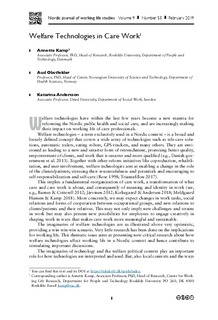| dc.contributor.author | Kamp, Annette | |
| dc.contributor.author | Obstfelder, Aud | |
| dc.contributor.author | Andersson, Katarina | |
| dc.date.accessioned | 2019-10-24T10:56:01Z | |
| dc.date.available | 2019-10-24T10:56:01Z | |
| dc.date.created | 2019-09-26T16:31:05Z | |
| dc.date.issued | 2019 | |
| dc.identifier.citation | Nordic Journal of Working Life Studies. 2019, 9 (s5), 1-11. | nb_NO |
| dc.identifier.issn | 2245-0157 | |
| dc.identifier.uri | http://hdl.handle.net/11250/2624119 | |
| dc.description.abstract | Welfare technologies have within the last few years become a new mantra for reforming the Nordic public health and social care, and are increasingly making their impact on working life of care professionals.
Welfare technologies – a term exclusively used in a Nordic context – is a broad and loosely defined concept that covers a wide array of technologies such as tele-care solutions, automatic toilets, eating robots, GPS-trackers, and many others. They are envisioned as leading to a new and smarter form of retrenchment, promising better quality, empowerment of clients, and work that is smarter and more qualified (e.g., Danish government et al. 2013). Together with other reform initiatives like coproduction, rehabili- tation, and user-involvement, welfare technologies aim at enabling a change in the role of the clients/patients, stressing their resourcefulness and potentials and encouraging to self-responsibilization and self-care (Rose 1998; Triantafillou 2017).
This implies a fundamental reorganization of care work, a transformation of what care and care work is about, and consequently of meaning and identity in work (see, e.g., Barnes & Cotterell 2012; Järvinen 2012; Kirkegaard & Andersen 2018; Meldgaard Hansen & Kamp 2018). More concretely, we may expect changes in work tasks, social relations and forms of cooperation between occupational groups, and new relations to clients/patients and their relatives. This may not only imply new challenges and strains in work but may also present new possibilities for employees to engage creatively in shaping work in ways that makes care work more meaningful and sustainable. (...) | nb_NO |
| dc.language.iso | eng | nb_NO |
| dc.publisher | Roskilde Universitet | nb_NO |
| dc.rights | Attribution-NonCommercial-NoDerivatives 4.0 Internasjonal | * |
| dc.rights.uri | http://creativecommons.org/licenses/by-nc-nd/4.0/deed.no | * |
| dc.title | Welfare Technologies in Care Work | nb_NO |
| dc.type | Journal article | nb_NO |
| dc.type | Peer reviewed | nb_NO |
| dc.description.version | publishedVersion | nb_NO |
| dc.source.pagenumber | 1-11 | nb_NO |
| dc.source.volume | 9 | nb_NO |
| dc.source.journal | Nordic Journal of Working Life Studies | nb_NO |
| dc.source.issue | s5 | nb_NO |
| dc.identifier.doi | 10.18291/njwls.v9iS5.112692 | |
| dc.identifier.cristin | 1729795 | |
| dc.description.localcode | Copyright (c) 2019 Author and Journal Creative Commons License This work is licensed under a Creative Commons Attribution-NonCommercial-NoDerivatives 4.0 International License. | nb_NO |
| cristin.unitcode | 194,65,70,0 | |
| cristin.unitname | Institutt for helsevitenskap Gjøvik | |
| cristin.ispublished | true | |
| cristin.fulltext | original | |
| cristin.qualitycode | 1 | |

